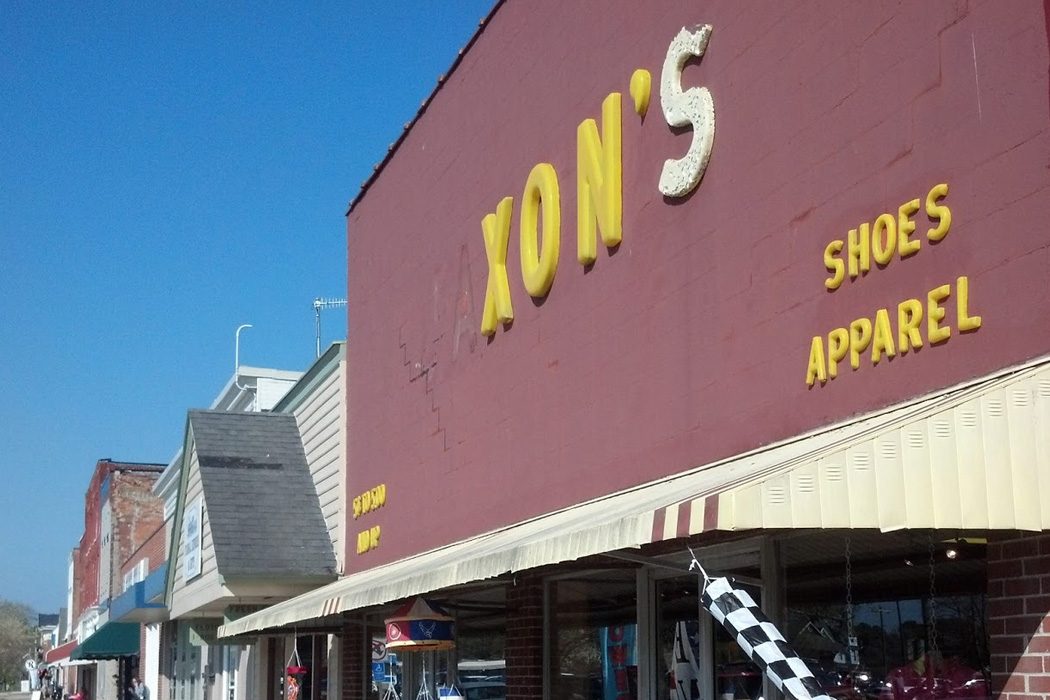These days I can get a pretty good green chile breakfast burrito and sit in trendy comfort at a table not three feet from where I was robbed in 1982. The old downtown drug store where I worked as a high school senior has transmogrified into a cafe. The iron and wood pulley elevator upon which I sweated hefting stock up to the attic has now been hauled from the shaft, adorned with fresh flowers, and repurposed as an entrance accent. My old hometown in the Virginia Piedmont is changing, and the store, where I bantered with pharmacists, ate pimiento cheese sandwiches browned on the foil-covered grill at the fountain, and yes, stared down a classmate who pulled a pellet gun on me one night, has a new, gentrified life.
Jaxon’s, meanwhile, has not made the transition. The principal business in the small, coastal town I now call home endures on its reputation. “If we don’t have it, you don’t need it,” the slogan goes. And Jaxon’s does seem to have all that a burgeoning 1960s-era town might want. Among the five-and-dime racks in its extensive aisles you can find: waxed shoe laces (brown & black), pocket New Testaments (KJV), bright plastic lunch boxes, yards of elastic, lacquered wood curios (some embedded with clocks), canvas work pants, steel-toed boots, sundresses, and Eastern Shore T-shirts. A more-than-adequate staff presides over this collection, all of whom know your name (and your business, the wags might add).
Walmart, our first, opened up down the road a few years ago. It seems that every other new business that manages an opening in our hard-luck county seems to have “Dollar” in its name. But, despite this environment, Jaxon’s survives. I think we’re spellbound by its survival and by the belief that the treasures of the ages are indeed stored in its unseen second story (no doubt accessed by an age-appropriate pulley elevator).
It’s an illusion, absolutely. In towns like ours such places go on because owners simply labor on. Economy stores come with their parking lots and prices and friction-less checkouts. Metal pre-fab construction mocks the crumbling brick walls and leaky tin roofs of Main Street. Thrift shops move in next door where the department store used to be. The laundromat shuts down because the town pipes can’t handle the load. A facade two blocks down opens onto a pile of rubble where the jeweler plied his trade. A knot of kids collects outside the storefront church, not for piety, but because the only change on the entire street is that it is now a stop for Pokemon Go. And if Jaxon’s has a next chapter, it will be because the wired world will find the Shore and make it safe for hipsters.
I’ve got no yearning for yesteryear. There’s comfort in the memories but it doesn’t change the fact that I still got stuck up at that manual, crunch-ding register 35 years ago. And old Southern towns certainly can’t claim moral superiority to their decaying, modern descendants. So I’m unsentimental when I walk downtown to Jaxon’s on bright, sunny days and enter through the stylish glass doors beneath large, yellow X-O-N-S letters posted over peeling burgundy paint. (For all its magic storehouse, the one thing Jaxon’s seems to lack is large yellow J’s and A’s.) I warm to see the metal scale which divines one’s weight AND future for two pennies, but I’m not tempted to mount it. I recognize, when my neighbor in a brown sales apron guides me to the location of the index cards and we talk along the way, that it’s a rare gift of interaction in the disconnected world.
But tomorrow I’m likely to go to Dollar General and thereby hasten the apocalypse.




